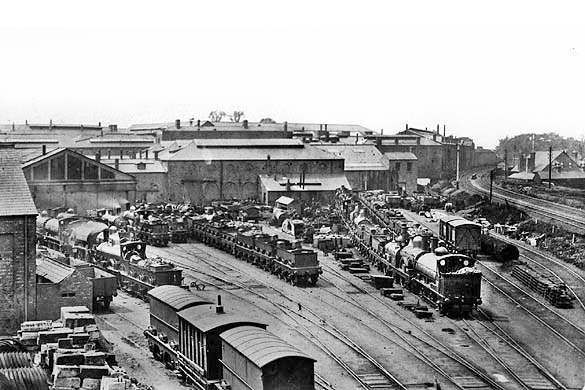 Looking west at the Stafford Road works and the locomotive shed from the LNWR Stour Valley line in 1886. The locomotive shed can be seen to the left and beyond it is the works. Broad gauge track had run into the shed and works until 1869. Looking west at the Stafford Road works and the locomotive shed from the LNWR Stour Valley line in 1886. The locomotive shed can be seen to the left and beyond it is the works. Broad gauge track had run into the shed and works until 1869.
Copyright photo from the John Alsop collection
|
The Shrewsbury & Birmingham Railway (S&B) opened their line into Wolverhampton on 12 November 1849. They opened workshops on the east side of their line at Stafford Road and also a locomotive shed. The facilities served their engines and rolling stock which ran between Wolverhampton and Shrewsbury. The S&B was a victim of the intense rivalry that existed at that time between the Great Western Railway (GWR) and the London & North Western Railway (LNWR). The latter wanted to prevent the former from reaching the River Mersey at Birkenhead and to do so they blocked the S&B from having a line of its own into Birmingham. In the end this led to the S&B forming an alliance with the GWR who took them over on 1 September 1854.
The GWR was forced to create its own route between Birmingham and Wolverhampton and in order to make a connection with the S&B it obtained an act in 1852 to build the Wolverhampton Junction Railway a ¾-mile line that ran from Cannock Road Junction to Stafford Road Junction. The course of the line cut through the S&B workshop site and a number of buildings had to be demolished to accommodate it. The line opened on 1 July 1854. The line was mixed gauge (The GWR broad gauge of 7 feet ¼ inch and the S&BR standard gauge of 4 feet 8½ inch).
The Locomotive Works
After the GWR had taken over the S&B they enlarged the facilities at Stafford Road. The GWR had a policy of making its own locomotives and spares. They decided to make Stafford Road their northern locomotive works and north division headquarters. They built a forge, a smithy and extra shops.
The main facilities were located in the triangle of land that was bordered by Stafford Road to the east, the course of the original S&B line to the south and the WJR line to the north. The latter line became the main line after November 1854 and the former became a dead-end branch that was renamed the Victoria Basin line after 1859.
There were also buildings on the south side of the Victoria Basin line and to the east of Stafford Road.
The first locomotive to be built by the works was completed in 1859. It was a 2-2-2 engine designed by Joseph Armstrong who had previously been locomotive superintendent of the S&B.
The GWR had favoured the broad gauge (7ft 0¼in) and had aspirations of extending it all the way to Birkenhead. However Parliament had appointed a Gauge Commission in 18xx and they had ruled that there should be a standard gauge and it should be 4ft 8½in (the most common gauge at the time). All new lines were to be built to the standard gauge. This meant that the GWR was never able to extend its broad gauge any further north than Stafford Road. For this reason Stafford Road became the main works for what they described as their ‘narrow gauge’ lines (those that were 4ft 8½in) but broad gauge engines were also built and serviced there.
Broad gauge engine-building and repair ended in 1869 when the lines between Wolverhampton and Birmingham were converted to standard gauge only.
Between 1859 and 1908 Stafford Road Works built 794 engines and carried out 102 rebuilds that were so extensive they could be classed as new engines.
In 1908 the GWR decided to concentrate locomotive building at Swindon. The decision was taken because of the availability of land for expansion, opportunities being limited at Wolverhampton, although extra land had been purchased 1900. The last locomotive to be built at Wolverhampton was a 2-6-2 tank engine No. 4519.
After locomotive building had ceased Stafford Road became a facility for carrying out overhauls and heavy repairs.
In 1932 new shops were built to the south of the Victoria Basin line on the land that had been bought in 1900. They dwarfed the older facilities and were fitted out with modern equipment.
On 1 January 1948 the GWR was nationalised and Stafford Road Works became part of British Railways [Western Region] (BR[WR]). Little changed under the new ownership and the works continued to carry out overhauls and repairs. In 1959 alone 310 locomotives and 183 boilers were repaired.
The BR modernisation plan of 1955 had decreed that steam locomotives would be phased out in favour of diesels and electrics. At first it was thought that Stafford Road would be re-equipped to maintain the new locomotives but it was not to be. Far fewer diesel and electric locomotives were required to do the same work and following the Re-shaping of British Railways report of 1963 (The ‘Beeching Report’) the railways were certain to contract.
On 1 January 1963 Stafford Road works passed to the British Railways [London Midland Region] (BR[LMR]) and on 11 February 1964 the last locomotive was outshopped. It was an ex-GWR 2-8-0 locomotive No.2859. The works closed in June 1964 making 500 men redundant.
The works were later demolished the land being given over to industrial and retail use.
The Locomotive Depot
The GWR opened a four road shed to service broad gauge locomotives in November 1854. The shed was located on the east side of Stafford Road to the north of the original S&B line (which became the Victoria Basin branch after 1859). The shed was connected to the WJR on the east side of the LNWR Stour Valley line which ran north/south on a viaduct. The WJR passed to the north of the shed marking its northern boundary.
In 1860 the GWR extended the shed so that it could also take standard gauge engines and after the demise of the broad gauge at Wolverhampton in 1869 it handled only that type.
In 1907 new facilities were provided included a coaling stage which was located to the east of the LNWR line.
In the last year of GWR ownership Stafford Road had an allocation of 75 locomotives.
On 1 January 1948 the shed became part of British Railways Western Region and remained busy throughout the 1950s. On 1 January 1963 the shed (84A) passed to the London Midland Region who closed it in September of that year. It was demolished shortly after closure.
|

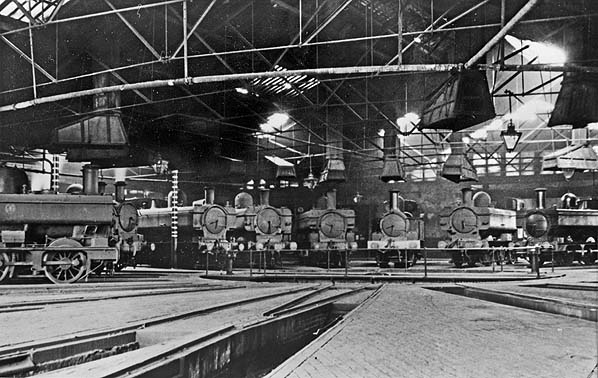
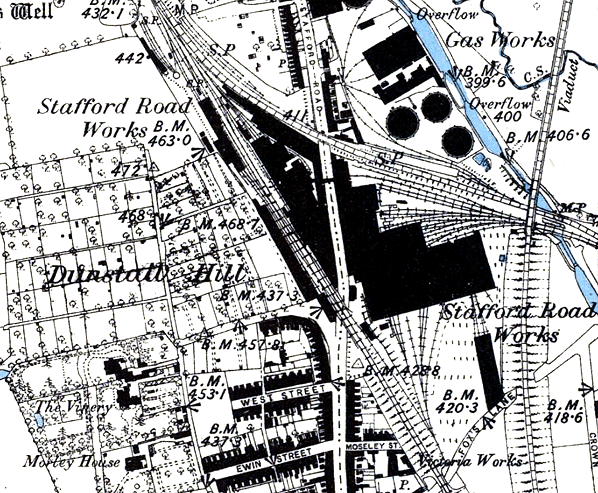
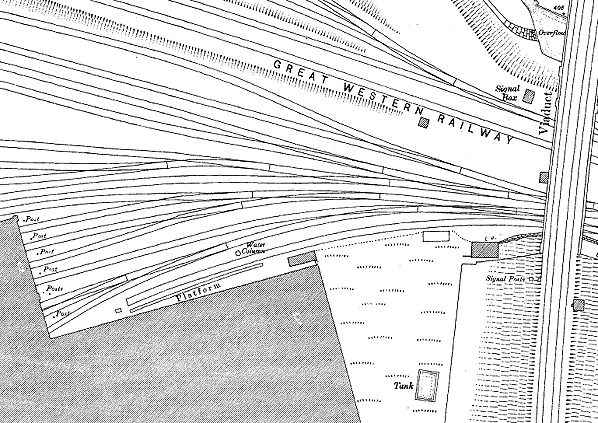
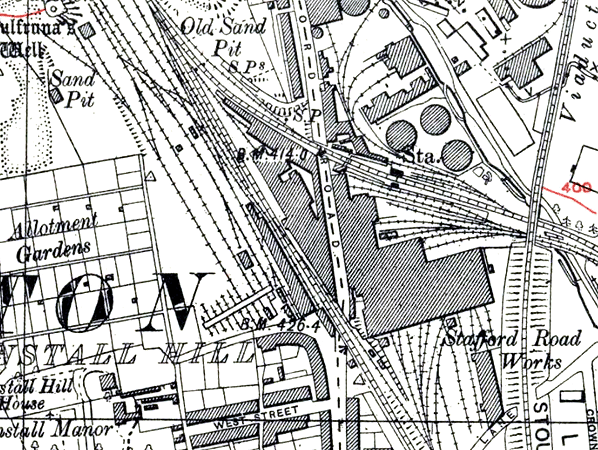
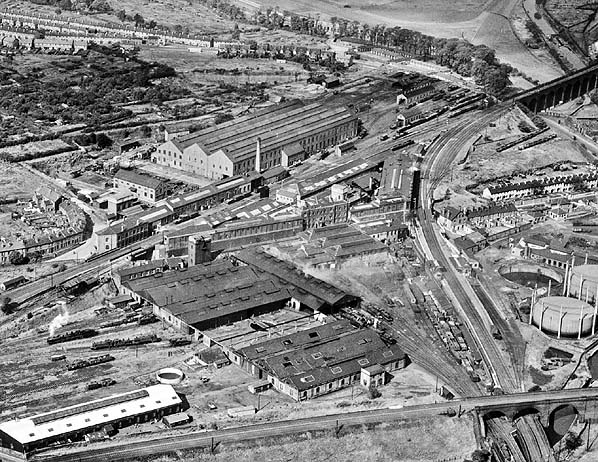
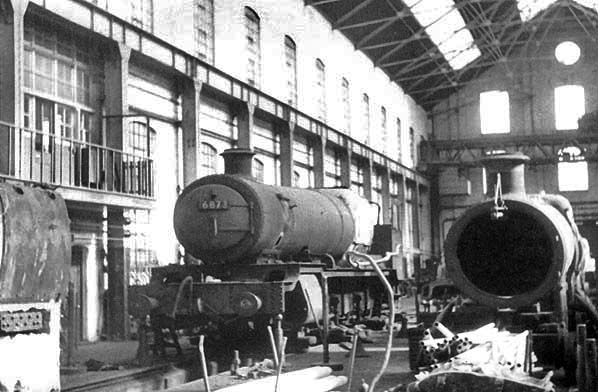
 Looking west at the Stafford Road works and the locomotive shed from the LNWR Stour Valley line in 1886. The locomotive shed can be seen to the left and beyond it is the works. Broad gauge track had run into the shed and works until 1869.
Looking west at the Stafford Road works and the locomotive shed from the LNWR Stour Valley line in 1886. The locomotive shed can be seen to the left and beyond it is the works. Broad gauge track had run into the shed and works until 1869.
 Home Page
Home Page